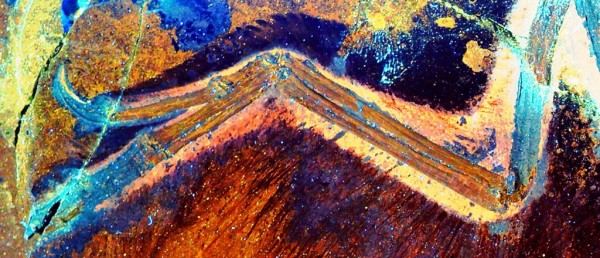By Ana Verayo, | March 01, 2017

The wing of the bird-like feathered Anchiornis dinosaur under laser-stimulated fluorescence. (Wang XL, Pittman M et al., Nature Communications, 2017)
Scientists have used state-of-the-art lasers to reveal many hidden secrets of dinosaur fossils. In a new study, researchers used lasers and cameras to determine the body shape and texture of a feathered dinosaur with four wings which is considered to be the ancestor of modern birds.
Some 200 fossils of this late Jurassic dinosaur called Anchiornis huxleyi was recently uncovered in China. A team from the University of Hong Kong then used a special technique known as laser-stimulated fluorescence (LSF) to analyze them.
Like Us on Facebook
This method involves the use of non-invasive laser light that can scan across a specimen while simultaneously capturing long exposure photographs with a regular DSLR camera. This process reveals invisible or hidden details that are crucial to understanding and analyzing a specimen.
According to the lead author of the study, paleontologist Michael Pittman of the University of Hong Kong, this special laser can "excite" the remaining skin atoms in the matrix that can make them glow. This would reveal the real shape of the dinosaur when it was alive.
Pittman explained why the Anchiornis dinosaur was chosen for this study. Despite being well-studied, these dinosaurs hold the key to understanding the origins of modern birds. There are about hundreds of well-preserved specimens of these dinosaurs.
Past studies revealed that the Anchiornis was completely covered in feathers and possessed not two but four wings, with one on each limb. Other studies also identified its black and white plumage and a red tuft on top of its head.
In this new study, Pittman and his team identified new physical features that cannot be determined with bone analysis alone. For example, they saw that the A. huxleyi had extra skin on its elbow called a propatagium. In addition, this winged dinosaur also had legs shaped liked a drumstick as well as a thin tail.
Scientists say that this propatagium helps modern birds to launch off the ground pre-flight. However, this does not mean that the ancient Anchiornis could propel itself upward and fly. This technique may seem fool proof but apparently, does not apply on all fossilized remains. Those bone fragments or fossils without any imprints cannot show crucial data using the LSF method.
Despite this limitation, Pittman says that scientific illustrators especially paleoartists or dinosaur artists can use this technique as a gold standard for the reconstruction of bird-like dinosaurs. Those artists who create sculptures, illustrations and animations of extinct animals can use the LSF to improve their craft's accuracy as well.
This new study was published in the journal, Nature Communications.
-
Use of Coronavirus Pandemic Drones Raises Privacy Concerns: Drones Spread Fear, Local Officials Say

-
Coronavirus Hampers The Delivery Of Lockheed Martin F-35 Stealth Fighters For 2020

-
Instagram Speeds Up Plans to Add Account Memorialization Feature Due to COVID-19 Deaths

-
NASA: Perseverance Plans to Bring 'Mars Rock' to Earth in 2031

-
600 Dead And 3,000 In The Hospital as Iranians Believed Drinking High-Concentrations of Alcohol Can Cure The Coronavirus

-
600 Dead And 3,000 In The Hospital as Iranians Believed Drinking High-Concentrations of Alcohol Can Cure The Coronavirus

-
COVID-19: Doctors, Nurses Use Virtual Reality to Learn New Skills in Treating Coronavirus Patients







